|
|
Information
Service of
the Serbian Orthodox Church
September 28, 2004

THEOLOGICAL
SYMPOSIUM IN POZAREVAC
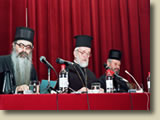 On
the occasion of the ten-year anniversary in office of Bishop Ignjatije
of Branicevo, a Theological Symposium was held in Pozarevac from
September 24-27, 2004, which brought together several eminent
contemporary theologians. On
the occasion of the ten-year anniversary in office of Bishop Ignjatije
of Branicevo, a Theological Symposium was held in Pozarevac from
September 24-27, 2004, which brought together several eminent
contemporary theologians.
The
Diocese of Branicevo was proud to host His Eminence Metropolitan
Joannis Zizioulas of Pergamum, Professor Dr. Stavros Jagazoglu
and the Very Reverend Abbot Simeon of the monastery in Drama,
Greece, as envoys of His All-Holiness Ecumenical Patriarch Bartholomew
of Constantinople, as well as His Eminence Metropolitan Kyrill
of Varna and Veliki Preslav, the representative of His Holiness
Patriarch Maksim of Bulgaria.
The
symposium began on Friday, September 24, 2004 at 7:00 p.m. in
Belgrade with a lecture by Metropolitan Joannis Zizioulas of Pergamum
on the theme “Ontology and Ethics”. Metropolitan Joannis was welcomed
before the overflowing amphitheater of the Theological Faculty
before the lecture on behalf of the students and professors by
the Dean, Protopresbyter Dr. Vladan Perisic.
[Coming
soon-1]
On
Saturday, September 25, 2004, the Theological Symposium continued
at 11:00 a.m. in Pozarevac. Protopresbyter-Stavrophor Dr. Radomir
Milosevic from Smederevo described the life of Bishop Ignjatije
prior to his consecration, and then reviewed his archpastoral
work in the Diocese of Branicevo.
[Coming soon-2]
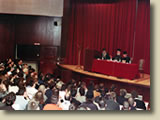 Father
Radomir Milosevic was followed by a lecture on the relationship
and differences between Western and Eastern ecclesiology delivered
by Professor Stavros Jagazoglu, who emphasized the importance
of eucharistic-episcopal ecclesiology without underestimating
the so-called therapeutic dimension of Christianity. The role
of the bishop in the diocese should be of primal importance to
every faithful person. The so-called healing theology came to
Orthodoxy from the West and in essence does not belong to the
authentic Orthodox experience of Christianity. Mr. Jagazoglu also
addressed the problem of secularism, underscoring that today borders
between the East and the West to not exist. He emphasized with
great respect the figure of Protopresbyter Georgiy Florovski,
who influenced contemporary Greek theologians, as well as our
leader of theology, Father Justin Popovic, who is also known in
Greek theological circles. Nevertheless, he gave the highest recognition
in the area of ecclesiology to His Eminence the Metropolitan of
Pergamum. He addressed words of high praise to Bishop Ignjatije
of Branicevo, emphasizing that he, too, has already made and continues
to make his mark on ecumenical Orthodox theology. Father
Radomir Milosevic was followed by a lecture on the relationship
and differences between Western and Eastern ecclesiology delivered
by Professor Stavros Jagazoglu, who emphasized the importance
of eucharistic-episcopal ecclesiology without underestimating
the so-called therapeutic dimension of Christianity. The role
of the bishop in the diocese should be of primal importance to
every faithful person. The so-called healing theology came to
Orthodoxy from the West and in essence does not belong to the
authentic Orthodox experience of Christianity. Mr. Jagazoglu also
addressed the problem of secularism, underscoring that today borders
between the East and the West to not exist. He emphasized with
great respect the figure of Protopresbyter Georgiy Florovski,
who influenced contemporary Greek theologians, as well as our
leader of theology, Father Justin Popovic, who is also known in
Greek theological circles. Nevertheless, he gave the highest recognition
in the area of ecclesiology to His Eminence the Metropolitan of
Pergamum. He addressed words of high praise to Bishop Ignjatije
of Branicevo, emphasizing that he, too, has already made and continues
to make his mark on ecumenical Orthodox theology.
At
5:30 p.m. Metropolitan Joannis Zizioulas of Pergamum held a lecture
on the office of bishop in the life of the Church. He emphasized
that a bishop is not just an administrator who takes care of his
diocese, as has become commonly accepted in our modern church
reality. As well, the office of bishop is not just the office
of a spiritual leader whose job it is to serve certain problems
among his faithful but, first and foremost, the liturgical practice
confirmed by the great Holy Fathers, from St. Ignatios to the
Cappadocians and St. Maxim the Confessor and all the way to St.
Gregory Palamas, that the figure of the bishop is one that unites
the disunited, and thus expresses the iconicity of the eschatological
banquet of the Kingdom of God. The Metropolitan also emphasized
the importance of hierarchical structure in the Church, and the
community as the essential element of the Church.
Metropolitan
Joannis then answered questions from the audience regarding personality,
regarding the Orthodox concept of marriage and the eschatological
understanding of marriage, and regarding the liturgical practice
of giving communion to priests.
His
Eminence Metropolitan Joannis Zizioulas of Pergamum served Holy
Hierarchal Liturgy on Sunday, September 26, 2004 in Pozarevac
in the cathedral of Holy Archangels Michael and Gabriel, starting
at 9:00 a.m. Concelebrating in the Holy Liturgy were Metropolitan
Kirill of Varna, Bishop Pahomije of Vranje and Bishop Ignjatije
of Branicevo, and many priests and deacons of the Diocese of Branicevo.
Metropolitan Kirill delivered the sermon and at the conclusion
Metropolitan Joannis conveyed the greetings of His All-Holiness
Ecumenical Patriarch Bartholomew of Constantinople. He then emphasized
that the office of bishop connects all local Churches, and that
the bishop together with his priests and faithful represents the
community of all local Churches. There are no divisions within
the framework of the Diocese or Church; thus, the Church is realized
as the Body of Christ in the bishop. Metropolitan Joannis then
presented Bishop Ignjatije with a panagia and a cross, the gift
of His All-Holiness Patriarch Bartholomew, and Metropolitan Kirill
presented Bishop Ignjatije with an Icon of the Most Holy Theotokos.
After
Holy Liturgy a formal luncheon was prepared for all those who
gathered in the church.

CHURCH
OF CHRIST THE SAVIOR IN BANJA LUKA RESTORED
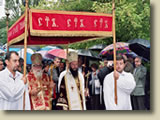 In
Banja Luka on September 26, 2004 the first Holy Liturgy was served
in the restored church of Christ the Savior, built on the foundation
if a church destroyed by the government of the Independent State
of Croatia in 1941. In this most sublime, prayerful manner, the
completion of construction work on this beautiful church. The
new church was built with a three layer wall: brick, concrete
and rock, as well as from red and yellow travertine, the most
durable and precious stone which is imported from Mesopotamia.
This is the first Serbian church with gold-plated cupolas. In
Banja Luka on September 26, 2004 the first Holy Liturgy was served
in the restored church of Christ the Savior, built on the foundation
if a church destroyed by the government of the Independent State
of Croatia in 1941. In this most sublime, prayerful manner, the
completion of construction work on this beautiful church. The
new church was built with a three layer wall: brick, concrete
and rock, as well as from red and yellow travertine, the most
durable and precious stone which is imported from Mesopotamia.
This is the first Serbian church with gold-plated cupolas.
 Holy
Hierarchal Liturgy was presided over by His Eminence Metropolitan
Nikolaj of Dabro-Bosnia with the concelebration of His Grace Bishop
Jefrem of Banja Luka, His Eminence Metropolitan Jovan of Veles
and Povardarje, the patriarchal exarch of the Autonomous Archdiocese
of Ochrid, His Grace Bishop Lukijan of Osijek Polje and Baranja,
His Grace Bishop Sava of Slavonia, His Grace Bishop Fotije of
Dalmatia, His Grace Bishop Gerasim of Gornji Karlovac, and His
Grace Bishop Maksim of Hum. Holy
Hierarchal Liturgy was presided over by His Eminence Metropolitan
Nikolaj of Dabro-Bosnia with the concelebration of His Grace Bishop
Jefrem of Banja Luka, His Eminence Metropolitan Jovan of Veles
and Povardarje, the patriarchal exarch of the Autonomous Archdiocese
of Ochrid, His Grace Bishop Lukijan of Osijek Polje and Baranja,
His Grace Bishop Sava of Slavonia, His Grace Bishop Fotije of
Dalmatia, His Grace Bishop Gerasim of Gornji Karlovac, and His
Grace Bishop Maksim of Hum.
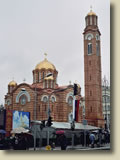 The
first church of Banja Luka Serbs from the Turkish period was a
small church dedicated to the Holy Trinity. After the Rebellion
of 1875, it was burned down and destroyed. In the year 1878 with
the annexation of Bosnia and Herzegovina by Austro-Hungary the
Serbs gathered the building materials; however, the first act
of the new occupying forces upon arrival was to confiscate all
the material from the Serbs and build themselves a garrison (today
the Bosanska Krajina Archive). In 1879 the first small church
was built. The foundation of the church of the Holy Trinity were
placed and consecrated on October 5, 1925 and the church was completed
and consecrated on the feast of the Ascension of Our Lord in 1939
by then Metropolitan Dositej of Zagreb and Ljubljana. Called “the
beauty from the Balkans”, the church was considered to be the
most beautiful of the Serbian Orthodox Church. On April 12, 1941
Banja Luka was bombed and the altar (sanctuary) apsid was damaged.
Stone by stone and brick by brick, Serbs, Jews and Roma were forced
by the Ustashe (Croatian Nazis) to destroy the church and clear
the site. The Communists prohibited the rebuilding of churches
in Banja Luka and for twenty-five years the city had no church.
Holy Liturgy was served in the chapel of the Bishop’s residence.
For his determined efforts to rebuild the church His Grace Bishop
Vasilije Kostic of Banja Luka was condemned as an enemy of the
state, and in August 28, 1953 he was banished from Banja Luka.
In 1992 rebuilding of the church of the Holy Trinity began after
the fall of the Communists. On October 17, 1993 His Holiness Serbian
Patriarch Pavle consecrated the foundation with about ten of his
Bishops, twelve priests and four deacons. The
first church of Banja Luka Serbs from the Turkish period was a
small church dedicated to the Holy Trinity. After the Rebellion
of 1875, it was burned down and destroyed. In the year 1878 with
the annexation of Bosnia and Herzegovina by Austro-Hungary the
Serbs gathered the building materials; however, the first act
of the new occupying forces upon arrival was to confiscate all
the material from the Serbs and build themselves a garrison (today
the Bosanska Krajina Archive). In 1879 the first small church
was built. The foundation of the church of the Holy Trinity were
placed and consecrated on October 5, 1925 and the church was completed
and consecrated on the feast of the Ascension of Our Lord in 1939
by then Metropolitan Dositej of Zagreb and Ljubljana. Called “the
beauty from the Balkans”, the church was considered to be the
most beautiful of the Serbian Orthodox Church. On April 12, 1941
Banja Luka was bombed and the altar (sanctuary) apsid was damaged.
Stone by stone and brick by brick, Serbs, Jews and Roma were forced
by the Ustashe (Croatian Nazis) to destroy the church and clear
the site. The Communists prohibited the rebuilding of churches
in Banja Luka and for twenty-five years the city had no church.
Holy Liturgy was served in the chapel of the Bishop’s residence.
For his determined efforts to rebuild the church His Grace Bishop
Vasilije Kostic of Banja Luka was condemned as an enemy of the
state, and in August 28, 1953 he was banished from Banja Luka.
In 1992 rebuilding of the church of the Holy Trinity began after
the fall of the Communists. On October 17, 1993 His Holiness Serbian
Patriarch Pavle consecrated the foundation with about ten of his
Bishops, twelve priests and four deacons.
 “We
have waited more than 60 years for the restoration of this church.
Many generations have died in expectation, and those whose faith
was not strong lost all hope. The Church sincerely prayed and
waited, knowing that a past injustice must one day be righted,”
said Bishop Jefrem of Banja Luka. He warmly thanked Republika
Srpska President Dragan Cavic, who in addition to his personal
contribution demonstrated ongoing interest in the progress of
the construction and tried to ensure than the problems that arose
were favorably resolved so that work could continue. Bishop Jefrem
also thanked successful business leaders and eminent individuals,
the Krajina Construction Company, a team of architects and engineers
who supervised the work, and all those involved who contributed
in any way for the first phase of work on the church to be successfully
completed. He also warmly thanked the media for broadcasting the
Holy Hierarchal Liturgy and the Jedinstvo (Unity) Choir for making
the ceremony more beautiful. Bishop Jefrem noted that when the
building and consecration of the church is complete a Monograph
will be published that will include not just the history of the
first church and its present restoration but also a list of contributors
and every donor’s contribution. “We
have waited more than 60 years for the restoration of this church.
Many generations have died in expectation, and those whose faith
was not strong lost all hope. The Church sincerely prayed and
waited, knowing that a past injustice must one day be righted,”
said Bishop Jefrem of Banja Luka. He warmly thanked Republika
Srpska President Dragan Cavic, who in addition to his personal
contribution demonstrated ongoing interest in the progress of
the construction and tried to ensure than the problems that arose
were favorably resolved so that work could continue. Bishop Jefrem
also thanked successful business leaders and eminent individuals,
the Krajina Construction Company, a team of architects and engineers
who supervised the work, and all those involved who contributed
in any way for the first phase of work on the church to be successfully
completed. He also warmly thanked the media for broadcasting the
Holy Hierarchal Liturgy and the Jedinstvo (Unity) Choir for making
the ceremony more beautiful. Bishop Jefrem noted that when the
building and consecration of the church is complete a Monograph
will be published that will include not just the history of the
first church and its present restoration but also a list of contributors
and every donor’s contribution.

[Serbian
Translation Services]
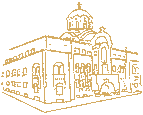
Copyright © 1999-2004 by
The Information Service of
the Serbian Orthodox Church
11000 Belgrade
Kralja Petra I no.5
+381 11 3282 596
e-mail
|

